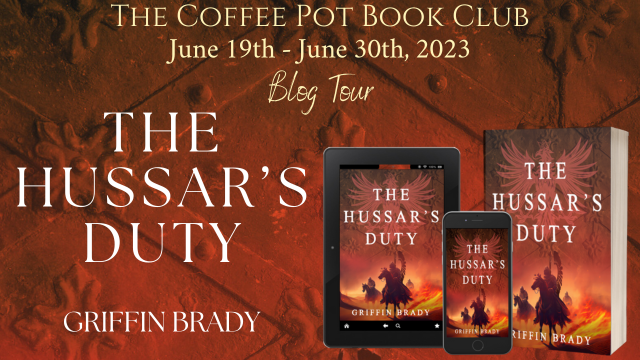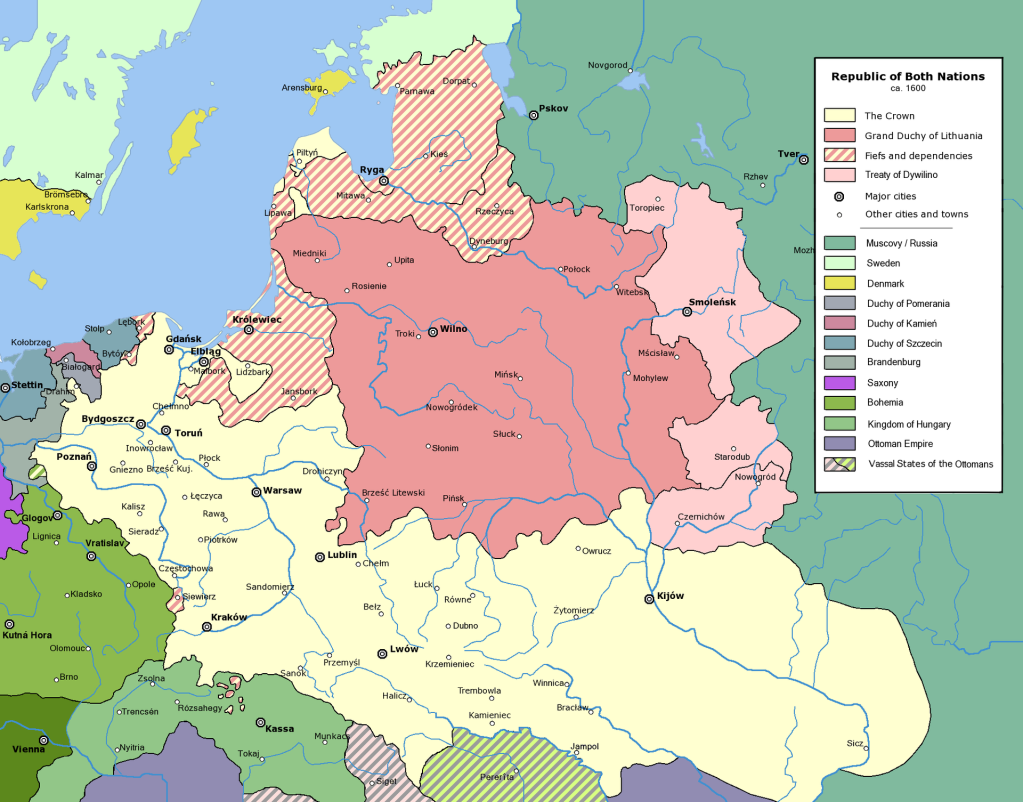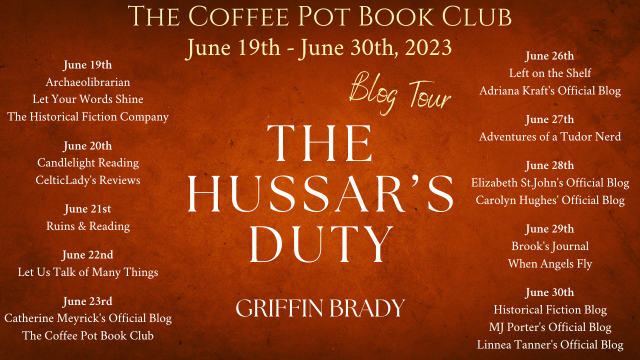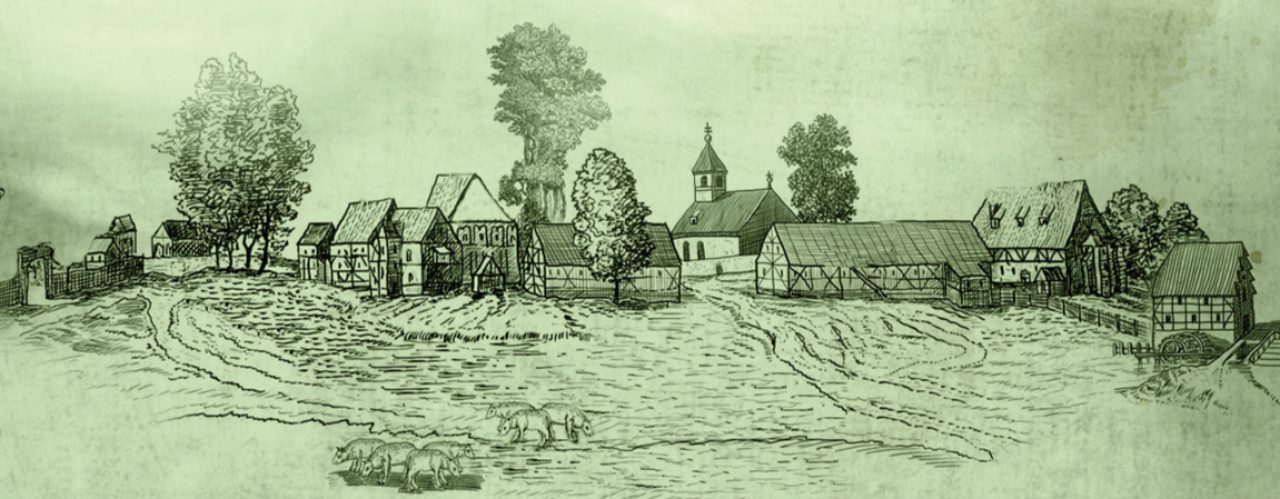Today I am delighted to be hosting GRIFFIN BRADY on her Coffee Pot Book Club book tour to share the recent publication of The Hussar’s Duty, the third book in her historical fiction series, The Winged Warrior.
On my blog today, you can find out more about The Hussar’s Duty, and read a fascinating article by the author, which discusses the historical background to The Winged Warrior series and The Hussar’s Duty.

What is the book about?
Poland’s most valiant winged hussar is called to fight in a campaign ripe for disaster. But he must also protect those he loves from jackals waiting to pounce. How does he choose between duty and devotion when death is on the line?
When Sultan Osman II sends Poland’s envoy packing, the Commonwealth must prepare for war against one of the largest armies the Ottomans have ever assembled. Tasked with repelling the invasion is Grand Hetman of the Crown Stanisław Żółkiewski, and he knows who to turn to: Jacek Dąbrowski, the Commonwealth’s most valiant Polish winged hussar.
Jacek has been idle far too long, and the call to arms is a siren’s song he can’t resist. But he has built a life far from the battlefield with his wife, Oliwia, and their children. If he pursues his quest for glory, who will safeguard them?
Oliwia knows her husband is restless. In fact, she’s been sending Jacek on cross-country errands for years in the hopes of quelling his lust for battle. When she realizes her efforts are futile, she resolves herself to letting him go—after hatching a scheme to accompany him.
Honor. Obligation. Devotion. These forces push and pull Jacek in different directions. His country needs him, but so does his family. Where does his duty lie? His choice will cause catastrophic ripples no matter which path he follows … and could very well bring the loss of his loved ones or his life.
Will the cost of defending king and country prove too steep for this warrior?
This is a standalone continuation in The Winged Warrior Series.
Learn more about the historical background to the series
Europe’s 16th century was a time of transition from the Renaissance to the Baroque, and in the Kingdom of Poland, it was an era marked by cultural enlightenment, democracy, and religious freedom—a golden time. But it was not a peaceful one, nor would it be. It was during this age that an elite group of armored cavalrymen known as the “Polish winged hussars” evolved and were recast as a jaw-dropping fighting force that would impact warfare for centuries to come. The hussars were exceptionally trained, highly skilled shock troops. They were the Polish Renaissance version of the U.S. Navy S.E.A.L.s, and they were formidable.
In 1569, Poland formally united with Lithuania. Their alliance was known as the Polish-Lithuanian Commonwealth, generally referred to as the “Commonwealth.” With an area spanning over 400,000 square miles and a population of 11 million, it was one of the largest countries in Europe. The Commonwealth shared an elected king and their parliaments—the Sejm. Birthright was not a guarantee to the throne, and a king did not have to be of Polish or Lithuanian nationality to be elected. Though Poland’s and Lithuania’s armies were similarly structured, they were fielded separately. Soon after the formation of the Commonwealth, the Polish winged hussar became a fundamental component of its fighting force.

The hussar was a complex amalgam of eastern and western influences. While Polish armies had been based on western Europe’s medieval knight—complete with cumbersome armor and heavy lance—Lithuania’s military borrowed from Byzantine, Russian and Mongol traditions. The first hussars to appear were unarmored Serbian light cavalry with shields, and their force soon grew to include Polish, Lithuanian and Hungarian recruits. In the 1550s, companies were a mishmash—a mix of heavily-armored, western style lancers and the lighter hussar cavalrymen who sometimes sported western armor as they fought alongside the heavy lancers.
Not until the election of King Stefan Batory in 1576 did these two forces blend together in one consistent “heavy” cavalry, abandoning the shield and taking up armor in its stead. King Stefan’s newly created heavy hussars were soon battle-tested and proved themselves a dominant force, and by the 1590s, the prototype was consistent throughout the Polish army.
The Commonwealth was perpetually scuffling with its neighbors. Land grabs see-sawed back and forth, and borders shifted and changed as one country seized the territory of another. The Commonwealth’s holdings from the 15th to the 18th centuries were vast, and it exercised its right to protect its borders and its people through a strong military presence. Cossacks and Russians threatened its eastern border; Sweden swept in from the north; Crimean Tatars raided across the southeastern edge while the Ottoman Empire was expanding its territory northward in a bid to conquer all of Christian Europe.
Unlike many of our modern-day armies, Poland only fielded a small standing army. This permanent force, the “kwarciani,” was three to five-thousand strong, of which a thousand were hussars. The kwarciani were garrisoned mainly along the Commonwealth’s southeastern border to deter constant threats of invasion. When the need for a large force mounted in the face of war, a lêvée en masse was issued, and the King sent letters of recruitment to amass companies. A company was typically raised by a wealthy, landed nobleman, and he acted as their commander, their “rotamistrz.” His was a private company, and he fought alongside the warriors he recruited—also noblemen. Because the rotamistrz and the hussars he called forward had the wherewithal to cover the cost associated with such an endeavor, the Sejm did not have to scramble for funds at the outset. While the men did earn wages, their expenses outstripped their pay. These noblemen willingly answered the call because they were motivated by duty, love of country, and honor. They were said to have had one of the highest morales among Commonwealth troops.
Polish husaria banners were formed in the traditional chivalric manner of the medieval knights. These lancers came from the nobility class—the “szlachta”—because the expense of raising and fielding such a soldier was enormous.
Their tactics were highly effective on the open ground—which comprised a major part of their geography—as documented in reports that still survive today. Narratives recount the decimation of an enemy’s front line after sustaining only one or two of the hussars’ impressive charges. The sight of a wall of armored cavalrymen clad in animal pelts riding at an enemy full out with leveled lances was terrifying and spectacular. Whether the wings added to the adverse psychological effect has been greatly debated, but certainly they did not lessen the intimidating visual impact wrought by such a charge, and they no doubt enhanced its magnificence. They flexed their formidable muscle for over a hundred years, garnering respect and dread from those familiar with their feats. They are now the stuff of legends.
My series is about these Polish winged hussars and is set in the early 17th century, just after the Commonwealth had hit its zenith as a world leader and before its decline later in the century. Like the tales of so many countries, the reason for that decline is complicated, but it was aided in part by the country’s many wars and the in-fighting among the governing nobles. The history of this time is rich, and I hope to spur readers to investigate further.
(Thank you, Griffin, that was extremely interesting!)

Book details
The Hussar’s Duty was published on May 18th 2023 by Trefoil Publishing.
It is available to buy from Amazon and is offered on KindleUnlimited.
Buy links
Amazon US • Amazon UK • Amazon AU • Amazon CA
About the author
Griffin Brady

Griffin Brady is an award-winning historical fiction author with a keen interest in the Polish Winged Hussars of the 16th and 17th centuries. She is a member of the Historical Novel Society and Rocky Mountain Fiction Writers. Her debut novel, The Heart of a Hussar, was a finalist for the 2021 Chaucer Early Historical Fiction Award and a 2021 Discovered Diamond.
The proud mother three grown sons, she lives in Colorado with her husband. She is also an award-winning bestselling romance author who writes under the pen name G.K. Brady.
You can connect with Griffin and follow her on Social Media:
Book Bub • Amazon Author Page • Goodreads
See who else is sharing Griffin’s book tour!

Follow the Coffee Pot Book Club and find out about other great historical reads on
Twitter and Instagram.

Thank you for hosting Griffin Brady today, Carolyn. I found her guest post very interesting.
Cathie xx
The Coffee Pot Book Club
LikeLike